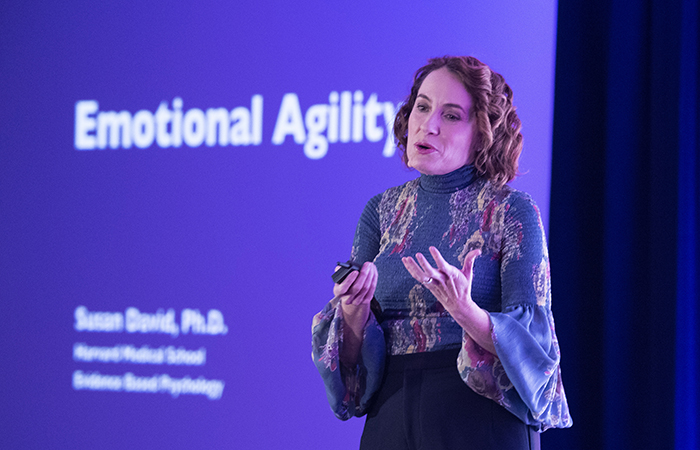Agility is a hot topic today, as HR leaders strategize how to help their organizations manage unprecedented changes brought about by advances in technology and evolving employee expectations. While reskilling is one way to arm the workforce to be future-ready, another is more internal.
“There is no organizational agility without emotional agility,” says Susan David, co-founder and co-director of the Institute of Coaching at McLean Hospital and a psychologist on the faculty of Harvard Medical School. The author and CEO of consultancy Evidence-Based Psychology shared her vision about the value of emotional agility during BetterUp’s Shift Conference last month.
Emotional agility, David says, essentially involves a “radical acceptance of our emotions,” a process that she said is the cornerstone to resilience and thriving–key in this rapidly changing world of work.

“Organizations are saying to people, ‘We need to you have particular qualities, we need you to be agile.’ And they describe it as outcomes: collaborative, innovative, creative, relational, customer-focused–all of these things that they say will allow them to navigate change,” she says. However, what many business leaders are missing, David notes, is the paradox that, with greater complexity, humans are naturally inclined to behave in ways that eschew all of those desired outcomes.
“When people are faced with stress and ambiguity–which are par for the course in complexity–we do the opposite,” David says. “It’s not that we want to, it’s that humans are wired so that when they feel great levels of stress and ambiguity, instead of being collaborative, we are more tribal, more competitive. Our perception narrows our focus to what we’re doing and we’re more likely to experience panic, strain, guilt and focus on transactional tasks. So the same complexity that drives the need for these outcomes also undermines them.”
And that is where emotional agility can come into play, David says.
Among the steps to embedding emotional agility in one’s life is showing up to our feelings, including practicing self-compassion and being kind to ourselves despite failure. We must also acknowledge our emotions for what they really are, such as owning our disappointment instead of masking it as stress, she says. “Walking our why” is a way to take values-driven action based on the true emotion–for instance, recognizing stress instead as disappointment can signify that you care deeply about something, which may prompt a different course of action than one would normally take when confronted with stress.
Emotional agility can help people to resist being “hooked” by a particular emotion, or to be driven in negative ways by an emotion during a moment in time, David adds.
“The skills of emotional agility allow you to recognize what you’re feeling, understand what it is, not be driven by it, be more intentional and, ultimately, close the gap between the things you’re trying to do and the outcomes.”
Since that practice is largely internal, how is emotional agility applicable on a broad, organizational scale?
David says it largely comes down to psychological safety. Often, she says, workers feel like they’re in a double bind. For instance, they’re asked to be innovative, but are punished if they fail in their attempts at innovation, and they’re asked to be collaborative but are rewarded entirely based on their individual contributions.
Many companies, David says, mistakenly allow the “tyranny of positivity” to permeate–workers are expected to be upbeat, suppressing emotions that are seen as negative. A research project she was involved with found that, of 70,000 workers, about a third treat such emotions as if there’s “something wrong with them,” discounting feelings like frustration or anger as “just being stressed.”
“When organizations force positivity, force people to just get on with things or get over things, they inadvertently crush innovation and crush their ability to be a learning organization,” she says. “Successful change has an intimate dance with failure, and you can’t get true collaboration unless you’re open to failure.”
HR can play a key role in helping business leaders recognize the need for psychological safety, David says, specifically monitoring all functions of the business for pain points. Particularly, when signs start to suggest any of three fundamental employee needs are not being met–workers’ ability to feel a sense of belonging, competence and autonomy–attention should be directed to building a safer environment.
Some HR leaders have expressed a concern that psychological safety could give workers the authority to behave poorly–that allowing employees to own their anger or frustration could lead to confrontations.
That’s an erroneous fear, David says.
“Allowing dissent in a room isn’t the same as giving people license to act with impunity,” she says, noting a leader who acknowledges his or her own flaws or addresses frustrations within the organization can model for employees that they can safely present their “emotional truth” at work.
“You don’t get to say to employees, ‘I want you to bring this part of yourself but not that part.’ You just don’t,” she says. “Diversity isn’t just gender and traditional markers–it’s also what’s inside people, including the diversity of thought and diversity of emotions. For an organization to be truly diverse, it needs to actually be open to the full range of the human experience.”

